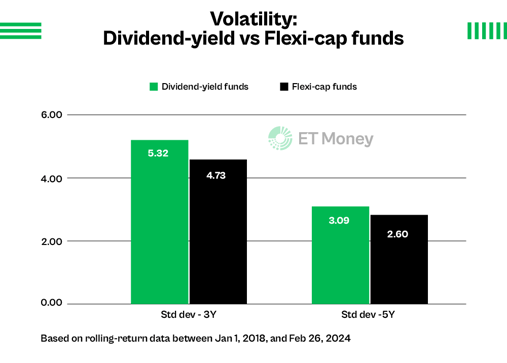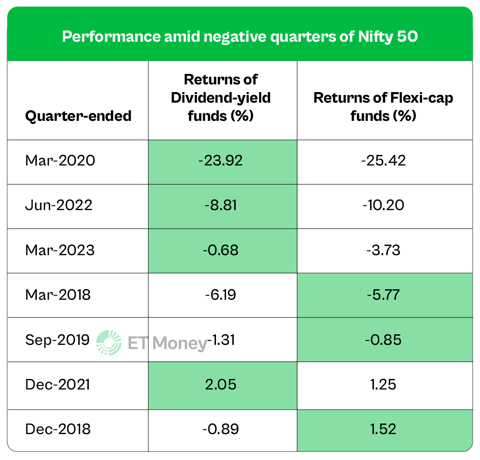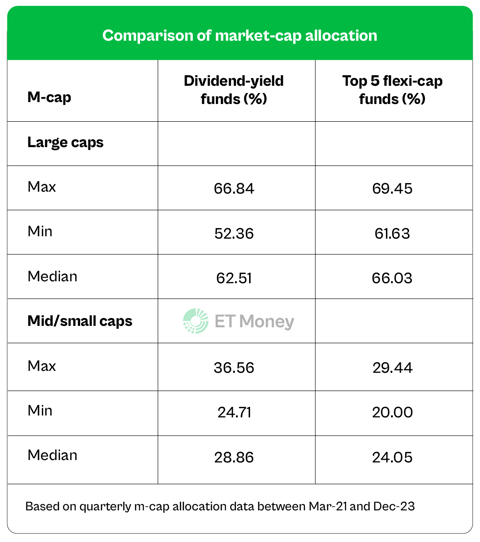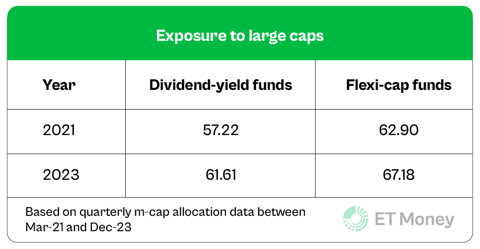Dividend-yield funds
Are dividend-yield funds a worthy alternative to Flexi-Cap schemes?
FINANCIAL SERVICES
ET Money
3/15/20243 min read


Last 3-year returns:
Flexi-cap funds = 20.2%
A little-known category = 27.1%
Which is this category? Is it a worthy alternative to Flexi-cap schemes?
Let’s dig in. 👇
The category we are talking about is Dividend-yield funds.
In this explainer, we will cover their 3 key aspects:
- Investment universe
- Performance against Flexi-cap funds
- Secret sauce of Dividend-yield funds
Let’s start.
INVESTMENT UNIVERSE
These funds invest in dividend-yielding stocks.
Over 1,492 companies on the BSE met this criteria. These funds can invest your money in any of these companies.
So, they have a broad universe, just like Flexi-cap funds.
Right now, there are just 9 funds in this category.
Each fund has its unique strategy for selecting stocks.
They prioritize dividends but also consider other factors in their selection process.
Check some examples 👇


The idea behind Dividend-yield funds is simple.
Companies that pay dividends have a stable business and are profitable.
Given the higher yield and stable businesses, these funds try to pick solid businesses that are less volatile and fall less in a down market.
Dividend-yield funds vs Flexi-cap funds
Trailing returns show Dividend-yield Funds have an edge.
But it’s also important to check consistency.
So, we compared the average 3- and 5-year rolling returns.
Here also Dividend-yield funds are ahead of Flexi-cap funds.


Annual returns
We checked data since 2018.
Flexi-cap funds have done better in 3 years: 2018, 2019, & 2020.
Dividend-yield funds have stolen the show in 3 years: 2021, 2022, & 2023.
So, it’s a tie. But Dividend-yield funds have been leading only in recent years.


Volatility
To measure which schemes are more volatile, we checked their standard deviation.
The higher the standard deviation, the more the ups and downs.
Guess what?
Despite their mandate for stability, Dividend-yield funds ended up being more volatile.


Ability To Protect Losses
Lastly, we checked how these funds contain the downside compared to Flexi-cap funds.
In 4 out of 7 quarters when the Nifty 50 gave negative returns, Dividend-yield funds did better than Flexi-cap funds.


Overall, Dividend Yield funds appear a worthy option.
They have generated better returns, albeit at higher volatility.
But when you see downside protection, they have done well.
What’s working for these funds?
These funds are more agile than Flexi Cap funds.
Dividend-yield funds have moved quickly between different market caps based on the market cycle. (See image)
This is one key reason for better performance compared to Flexi-cap schemes.


Take calendar years 2021 and 2023 as examples.
Dividend-yield funds massively outperformed Flexi-caps.
In these years, their average large-cap exposures were 57.22% and 61.61%, respectively.
On the other hand, the top 5 flexi-cap funds held 62.9% and 67.18% in large caps.


For the top flexi-cap funds, getting deep into large caps is unavoidable.
Reason: Their large asset size (AUM).
They may find it challenging to allocate higher assets to mid/small caps.
On the other hand, thanks to their lower AUMs, dividend-yield funds can be more agile.
WRAP UP
Dividend-yield funds look promising.
But this does not mean you should stop your ongoing investments in Flexi-caps and start SIPs in dividend-yield funds.
This is category-level data.
Check your individual fund’s performance before making any decision.
Contact:
Office
3, Shree Shyamkunj Apartment, 56/2, Jayant Park Society, Bhaduatnagar, Ghodasar, Ahmedabad 380050 Gujarat India
+91 9104649042
